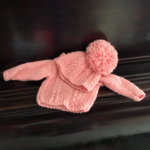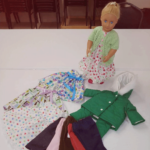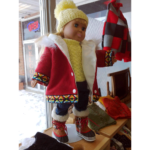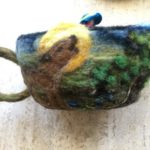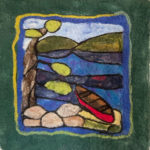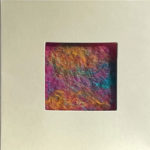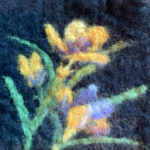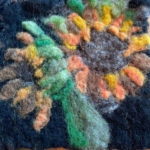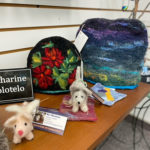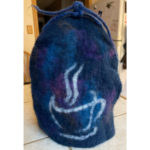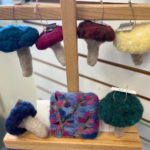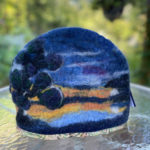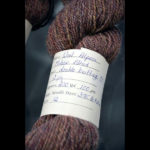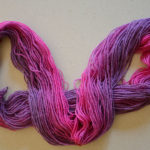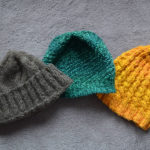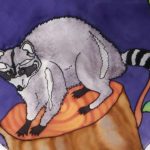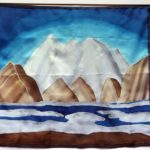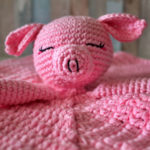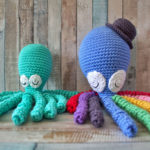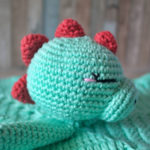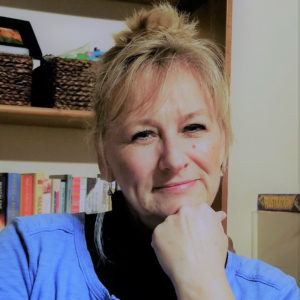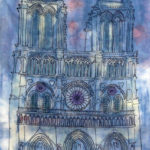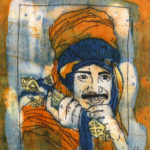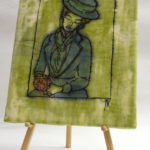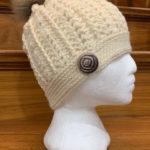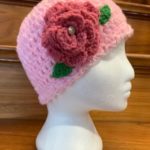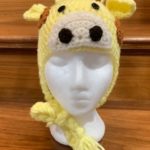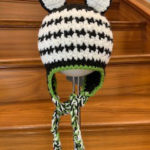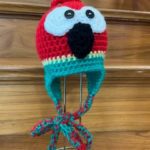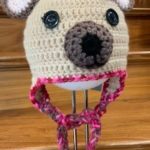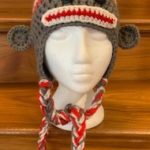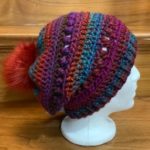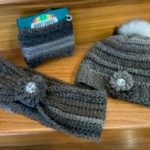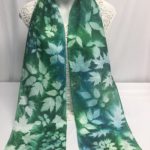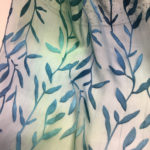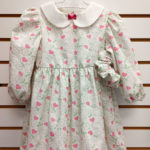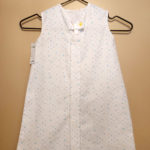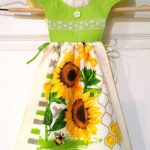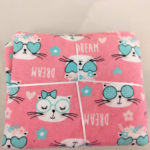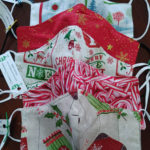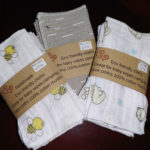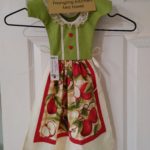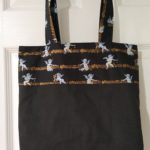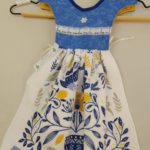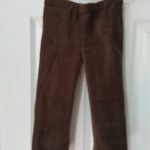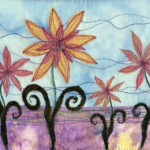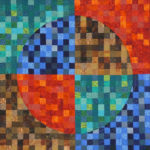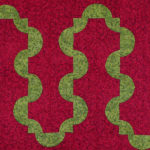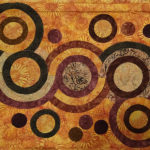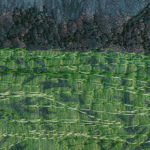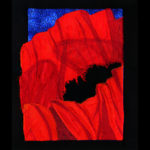
Nancy Adams
doll clothes
As a very young child, I started sewing and knitting with my older sister, making clothes for our dolls.
I bought my first sewing machine at 13 and made my own clothes as well as clothes for my daughters until my life became too busy to do so.
Then, grandchildren came on the scene and I started making doll clothes for their 18” dolls. It was fun, designing unique outfits for each.
But, then, after several years, my youngest of four granddaughters announced that she was now too ”old” for dolls. I continued to sew and knit doll clothes because I enjoyed it. My friends often purchased them for their grandchildren and encouraged me to sell them at craft sales.
I started selling them through the Gallery in June 2023. The varied styles are suited to little hands for many hours of play..
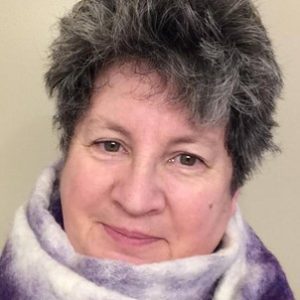
Catharine Colotelo
wet woolens
Catharine moved to Deep River with her husband and two small children in 2001. For the next 8 years her life was filled with raising her two boys and working for Atomic Energy of Canada. A shift in her direction occurred around 2009 when Catharine left work to pursue other endeavours. During this exploration she took some local felting classes and hasn’t looked back
Catharine has been felting since 2014. During that time Catharine has taken a few online classes as well as in-person felting classes. The techniques learned have enabled her to continue exploring the limitless possibilities there are with wool. She starts with the basic components that allow her to create wall hangings, clothes, three-dimensional objects, and more.
She has shown her work locally in the town of Deep River, ON and she has joined up with other groups that have exhibited her work in Ottawa and the Ottawa Valley. In 2020 her work was included in a published book, “Separate yet Connected”.
She is inspired to create by what she sees in her surroundings and by her experiences with current events. Rooms in her house serve as studio areas. You can see her work on Facebook by going to her Wet Woolens page.

Lois Freedman
hand-dyed yarns
Becky Bergeron
baby knits
Lois has lived the majority of her life in Deep River and has been knitting & crocheting since she learned these skills from her mother at an early age. Upon retirement, she expanded her hobby of knitting for her family to include preparing her own yarn.
Over the last decade, Lois has spun mostly locally-sourced wool, but she also enjoys blending-in exotic fibres such as qiviut, silk and hemp to make one-of-a-kind yarns. The fibres are often then dyed using a variety of dyes and techniques to produce effects unavailable commercially. After spinning, the yarns are suitable for knitting, crocheting & weaving projects.
Lois’s ongoing education includes courses taken at the Haliburton School of the Arts in subjects such as Colour Analysis, Shibori (Japanese-style dyeing), Quilting and Basic Spinning. The latter inspired her to complete the intensive six-year Spinning Certificate Program offered by the Ontario Handweavers & Spinners (OHS), from which she graduated “With Distinction”.
As well as being a member of the Deep River Weavers, and also the Gateway Guild of Weavers & Spinners (GGWS) in North Bay, Lois sits on the OHS board of directors as the Northern Region representative. She regularly gives workshops at the GGWS and at the Killaloe Fibre Arts Circle.
Her handspun yarns are available at the Valley Artisans’ Co-op along with a limited selection of knit items.
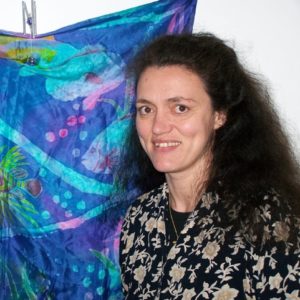
Katja Fritzsche
Silk Scarves & Crochet
Katja joined the Valley Artisans’ Coop in 2004.

Lidia Gilabert-Cobacho
Lidia’s Nook
My name is Lidia. I am originally from Spain, but I crossed the pond almost 10 years ago. I have been living in Deep River since September 2018, and I love all kinds of crafts, specially crochet and paper crafts. When I’m not crocheting, scrapbooking or making cards, I enjoy the outdoors, specially hiking and taking photos of nature.
When I was little, my grandmother tried to teach me the arts of crochet, knitting, embroidery, and sewing, but I was more interested in playing and didn’t pay much attention, so I didn’t learn much. Doilies and tea towels are not very appealing for an 10 years-old girl.
A few years ago, at an artisans market, some adorable crochet animals and dolls caught my attention. It was very different from what my grandmother had tried to teach me. So, I asked the artisan about it, and he told me it was a Japanese technique called Amigurumi, which means “crocheted stuffed toy.” After that, I started researching this fascinating technique. While browsing the internet, I came across some YouTube videos that taught me the basic crochet and Amigurumi stitches. Then, I joined a chat group of Amigurumi artisans, and we help each other with tricks to improve and progress. In order to practice, and taking advantage of having two nieces on the way, I made them a stuffed toy for their cribs. They weren’t perfect, but I put all my love on them. After many years they still cherish them dearly. Since then, every newborn in the family receives a special handmade piece from me.
Why give an Amigurumi as a gift?
According to tradition, each Amigurumi has a “soul” that makes it the lifelong companion and confidant of its owner, providing protection and comfort in times of stress and sadness. In some cases, they are used as personal charms and also in homes, businesses, and workplaces.
It is said that they do not have a mouth (although they can also be made with a mouth) because they feel the same as their owner. So, if their owner is happy, they will accompany them in their joy. And if they are sad, they will accompany them in their sorrow.
Additionally, as their confidant, since they don’t have a mouth, they will never reveal their secrets.
Although the origin of Amigurumi is not clear, it is believed to have roots in China, where records of knitted dolls have been found from the Shang Dynasty.
In Japan, they began to appear in the early 17th century during the Edo period.
This technique spread further in the late 19th century when the Dutch introduced knitting techniques to Japan.
These techniques became popular among the samurai, who created decorations for their katanas and garments.The samurai would knit using their fingers to maintain agility in their hands.
In the late 1970s, the kawaii culture emerged, and it began to gain popularity.
In the Western world, they became popular in the mid-2000s when video tutorials and online patterns started to appear.
The materials I use to make my Amigurumi are cotton yarn for the crochet work and synthetic fiber for the stuffing, safety eyes when they are not embroidered, felt to make some accessories, and some fabrics to make dresses.

Claire Kennedy
Miracle for Children FUndraiser
I got interested in crochet when I was 16 years old. My mother was taking a Beginner Crochet Course at a Continuing Education High School and was coming home with her completed projects. I told her that I was interested in trying this out, so she enrolled me in the next Beginner Course, while she took the Intermediate Course, the next semester. I became obsessed with intricate doilies and tablecloths at that time and made a number of them. After a while, my interests changed to needlepoint, then cross stitch and embroidery, so crochet took a back seat for several years. . . like over 30 years. Life happens! Marriage, children, jobs, a business or two or three!
When I retired in the Fall of 2009 and moved to Deep River, I joined the local Deep River and Area Jabez Blanket Ministry. The Ministry’s goal is to produce beautiful hand crocheted or knitted blankets that are added to a “Back Pack of Hope” and sent to orphanages around the world. I became heavily involved with this group and subsequently became the local coordinator. One of my tasks is to encourage donations of yarn from the local communities surrounding Deep River. Some of the yarn donated is not always suitable for blankets, so rather than dispose of it, I decided to try my hand at making head warmers and neck warmers. I began attending craft shows and my hats became very popular. I started out of course using patterns from designers which I found for free on the internet. In the last few years, I honed my skills and felt comfortable in tweaking designs to make them more my own. Since I have such a beautiful variety of yarn… different fibres, colours, weights and textures, I can use these to create a lot of one of a kind hats, headbands and neck warmers. I love to play with textured crochet stitches to see if they will work in “the round” for a hat. To make my product even more unique, I will often use clip on earrings, broaches or other types of embellishments, along with buttons to decorate an appliqué or the brim of a hat or neck warmer.
Since a lot of the materials I use are donated, all of the profit from the sale of my products goes to Charities… The Jabez Blanket Ministry International (which started it all) and other local grass root charities. I provide the labour at no cost, since crochet is also therapy for me. I love creating these useful accessories and then being able to help out worthwhile organizations.

Laura mayo
hand-dyed silk
Born and raised in the Ottawa Valley, Laura is surrounded by nature and strives to capture the beauty of her environment in her wearable artwork.
A long time member of the Valley Artisans Co-op in Deep River she has honed her skills over the years working with many different mediums.
A professional fiber artist, Laura has mastered the art of Sun dyeing, also known as Heliographic Printing. Over the past 15 plus years she has been collecting interesting looking plants, seeds, flowers and nuts from nature and her own back yard gardens to imprint their images on silk, rayon and cotton. Her one of a kind scarves are sold all over the world and are often shipped to distant lands as symbols of Canada, especially the ones she makes in Autumn colours using maple leaves, sumac, wild raspberry and beech nuts.
When the summer ends and the sun is no longer strong enough to sun dye, Laura turns indoors to continue the creative process by using other dye techniques like spray, ice and snow dyeing.
Durability is an important component of Laura’s work and everything she creates is made to be washed, ironed and stands the test of time.
To expand her accessory line Laura began to fashion scarf jewelry that perfectly matches the colours in her scarves. Using a selection of thousands of different beads, crystals and stones, Laura produces individual, unique and one of a kind pieces of jewelry that are used to hold and accessorize her scarves.
The vast colours found in alcohol inks attracted Laura several years ago to explore other mediums such as paper art and home décor. Anything that is colourful and vibrant is a magnet to Laura and her pursuit of new applications is boundless.
Come visit her at the Valley Artisans Co-op in Deep River or at one of the many art shows she exhibits at around Ontario.
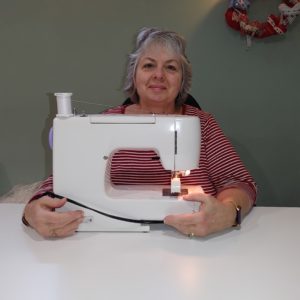
Connie Schwartzentruber
Connie’s Creations
When I joined the Valley Artisans Co-op in 2021, my husband and I had been in Deep River for less than one year.
My interest in sewing and knitting came at an early age while I was in high school and took the Home Ec course. I made clothes for myself back then and when our children came along, sewed for them during their childhood years.
When our grandchildren started to arrive, I knitted them all their first blankets as well as sweaters and, of course, slippers and mitts.
This year I will celebrate 50 years of sewing which has given me many hours of pleasure, as well as facing difficult projects and learning to problem solve and feeling a great sense of accomplishment.
I set up my business in 2014, giving it the official name Connie’s Creations. My display at the gallery has kept me very busy and I have built lasting friendships there as well as met many of the local people. It’s great fun to attend the craft shows around the Ottawa Valley where I continue to meet some wonderful, generous people.
My main focus is making baby/toddler clothing and accessories such as dresses, hats, rompers, house coats, sleep sacks, burp cloths, blankets, baby mittens, scrunchies and barrettes, as well as COVID masks, aprons, eco friendly cloths, and tea towel dresses to hang over the oven door.
I also take special orders and have been busy making memory bears/pillows. The customer brings me clothing from a loved one who has passed and I make them into a bear or pillow. I have made over 20 bears so far and around 15 pillows. It is such a satisfying project which brings such peace and comfort to those who are grieving.
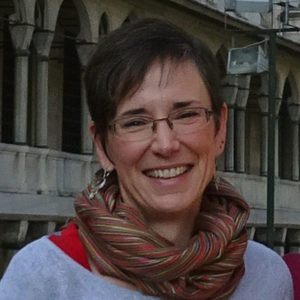
Leslie White
Quilting
I grew up in Prince Albert, Saskatchewan surrounded by visual art. My father is a retired architect and my mother was a weaver. Though I have little formal training, I spent my early years immersed in the local arts community and enjoying the art that filled my parents’ home.
In 1997, I moved to Deep River with my family, joining the Valley Artisan’s Co-op in 2007, the latest fork in a career path which has included teaching and raising kids.
I have been sewing almost as long as I can remember. My wise mother found ways to direct me to her sewing machine where I spent countless hours creating elaborate outfits for my fashion dolls and continued to sew my own (less elaborate) clothes.
My first ventures into fabric art and custom garments included hand-painted silk scarves, silk lingerie and dresses for weddings and graduations. Once I had children, I turned my energies towards more immediate and practical pursuits, sewing clothes and costumes and teaching the willing ones to sew for themselves.
I began my first quilt in 1997 for my daughters’ double bed. It took more than two years to complete, but was the inspiration for more. I created several wall-hangings from published designs before beginning to design for myself in 2006. I now concentrate my creative energies on wall-quilts of various sized, from letter-sized picture quilts to larger wall-hangings.
I see ideas everywhere, particularly in the natural world. I love the endless possibilities of colour, texture and pattern that quilting offers.


